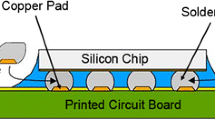Abstract
Tin-antimony and tin-indium-antimony alloys made using relatively simple processing steps are discussed as potential creep-resistant, lead-free solders. The intermetallic SbSn forms a very advantageous distribution of high aspectratio whiskers, providing a significant composite strengthening effect that is relatively unaffected by aging at temperatures below 100°C. The intermetallic InSb is even more effective than SbSn per volume fraction. Evidently, strong interactions between dislocations and InSb particles are the origin of the creep-rate reduction. Compared to other potential creep-resistant solder alloys, the creep properties of the Sn-Sb and Sn-In-Sb alloys compare favorably, particularly the high volume-fraction Sn-Sb alloys. It is suggested that even better creep resistance could be achieved in alloys containing distributions of both InSb particles and SbSn whiskers.
Similar content being viewed by others
References
H. Mavoori, JOM 52 (6), 29 (2000).
H. Mavoori and S. Jin, JOM 52 (6), 30 (2000).
J. Rösler, G. Bao, and A.G. Evans, Acta Metall. Mater. 39, 2733 (1991).
G. Bao, J.W. Hutchinson, and R.M. McMeeking, Acta Metall. Mater. 39, 1871 (1991).
J.L. Marshall, J. Calderon, J. Sees, G. Lucey, and J.S. Hwang, IEEE Trans. Comp., Hybrids, Manuf. Technol. 14, 698 (1991).
M. McCormack, S. Jin, and G.W. Kammlott, IEEE Trans. Comp., Packag., Manuf. Technol. Part A, 17, 452 (1994).
F. Guo, J.P. Lucas, and K.N. Subramanian, J. Mater. Sci.: Mater. Electron. 12, 27 (2001).
R.J. McCabe (Ph.D. thesis, Northwestern University, 2000).
R.J. McCabe and M.E. Fine, Metall. Mater. Trans. A 33A, 1531 (2002).
Thermo-calc, ver. L. (Stockholm, Sweden: Foundation for Computational Thermodynamics, 1996).
G. Simmons and H. Wang, Single Crystal Elastic Constants and Calculated Aggregate Properties: A Handbook, 2nd ed. (Cambridge, MA: MIT Press, 1971).
R.K. Mahidhara, S.M.L. Sastry, I. Turlik, and K.L Murty, Scripta Metall. Mater. 31, 1145 (1994).
M.D. Mathew, S. Movva, H. Yang, and K.L. Murty, Creep Behavior of Advanced Materials for the 21st Century, eds. R.S. Mishra, A.K. Mukherjee, and K. Linga Murty (Warrendale, PA: TMS, 1999), pp. 51–59.
R.J. McCabe and M.E. Fine, Metall. Mater. Trans. A 33A, 575 (2002).
E. Marquis and D. Dunand, Scripta Mater. 47, 503 (2002).
R. Darveaux and K. Banerji, IEEE Trans. Comp., Hybrids, Manuf. Technol. 15, 1013 (1992).
H. Mavoori, S. Vaynman, J. Chin, B. Moran, L. Keer, and M.E. Fine, Mater. Res. Soc. Symp. Proc. eds. R.C. Sundahl, K.-T. Tu, K.A. Jackson, P. Borgesen (Pittsburgh, PA: Mater. Res. Soc., 1995), pp. 161–175.
J.S. Hwang, Z. Guo, and G. Lucey, Surface Mount International, (Pittsburgh, PA: Mater. Res. Soc., 1993), pp. 662–676.
B. Chandran, W.F. Schmidt, M.H. Gordon, and R. Djkaria (Paper presented at 1996 ASME Int. Mechanical Engineering Congr. Expo., Atlanta, GA, 17–22 November 1996).
Author information
Authors and Affiliations
Rights and permissions
About this article
Cite this article
Mccabe, R.J., Fine, M.E. High creep resistance tin-based alloys for soldering applications. J. Electron. Mater. 31, 1276–1282 (2002). https://doi.org/10.1007/s11664-002-0021-y
Received:
Accepted:
Issue Date:
DOI: https://doi.org/10.1007/s11664-002-0021-y



